Top 5 Cities for Black Population Growth and top 5 Losers.
Released in June 2024, the U.S. Census Bureau’s Population Estimates reveal significant shifts in the Black alone population across various metropolitan areas from 2020 to 2023. These changes highlight patterns of migration, economic opportunities, and social dynamics within the Black community. Let’s discuss the top gainers, top losers, geographical differences, and the underlying reasons for these trends.
SEE FULL LIST OF 133 CITIES AND THIER POPULATION CHANGE SINCE 2020
Top Gainers: Economic Opportunities and Migration Patterns
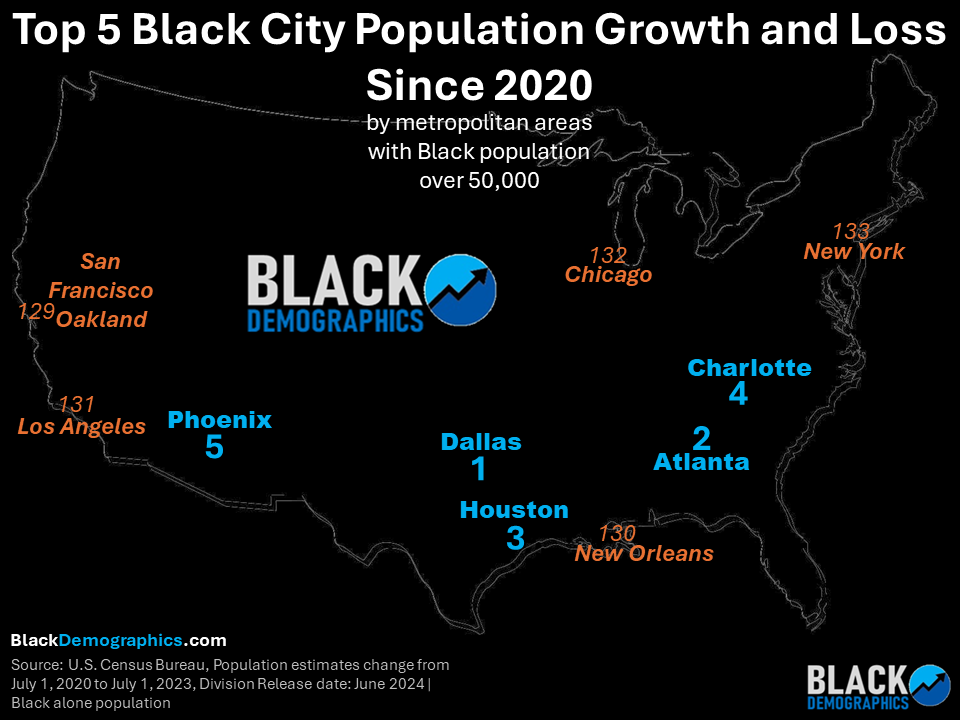
SEE FULL LIST OF 133 CITIES AND THIER POPULATION CHANGE SINCE 2020
1. Dallas-Fort Worth-Arlington, TX (+129,155) net growth
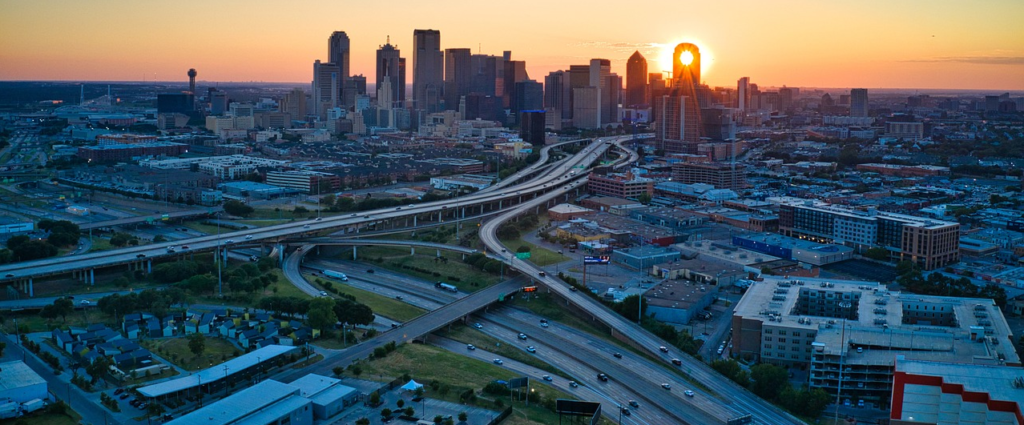
Reasons: The Dallas-Fort Worth area continues to be a major hub for job opportunities, particularly in the tech, finance, and healthcare sectors. Its relatively affordable cost of living compared to other major cities makes it attractive for Black singles and families seeking economic stability and upward mobility.
SEE FULL LIST OF 133 CITIES AND THIER POPULATION CHANGE SINCE 2020
This region has a relatively low per-capita college population, however a large number of African Americans with and without degrees migrate here from California, the mid-Southern states of MS, LA, AR, OK, TN, and the Midwest. There is also a growing population of immigrants from East and West Africa, namely Nigeria, Ghana, Kenya, and Somalia.
2. Atlanta-Sandy Springs-Roswell, GA (+126,460)
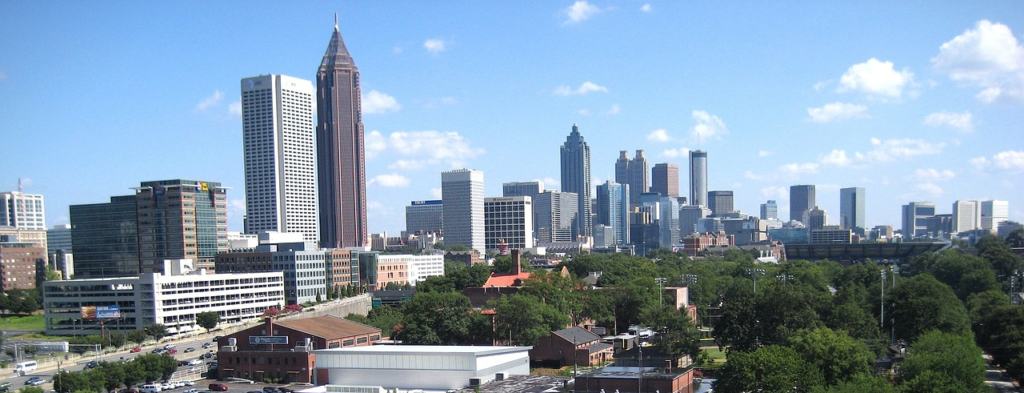
Reasons: Known as the “Black Mecca,” Atlanta has a thriving Black professional community and robust entrepreneurial scene. The large presence of historically Black colleges and universities (HBCUs) and a vibrant cultural scene further enhances its appeal.
A large number of migrants come here from the northeast along with a significant amount from all other regions of the nation. African and Caribbean immigration has also increased in the metro Atlanta area.
3. Houston-Pasadena-The Woodlands, TX (+114,507)
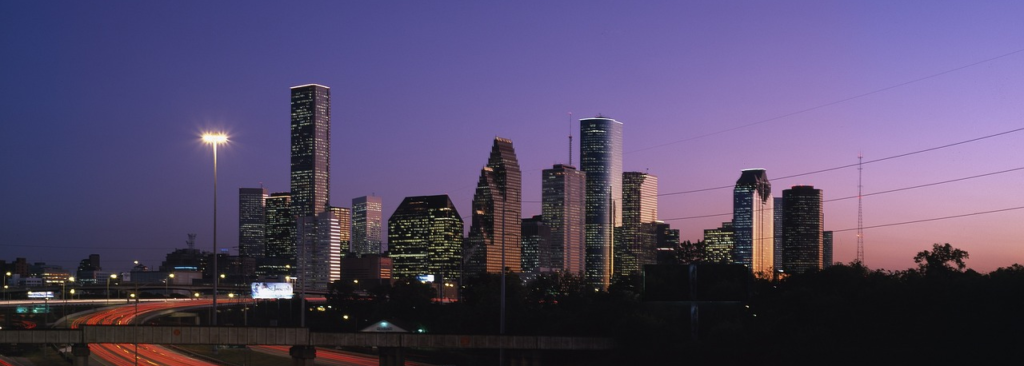
Reasons: Houston’s energy sector, medical industries, and port facilities offer numerous employment opportunities. Additionally, its diverse population and welcoming environment contribute to its growth.
The migration patterns moving into Houston are very similar to Dallas, however Houston did receive a much larger percentage of the post-Katrina Black population from New Orleans than any other city outside of Louisiana.
4. Charlotte-Concord-Gastonia, NC-SC (+42,985)
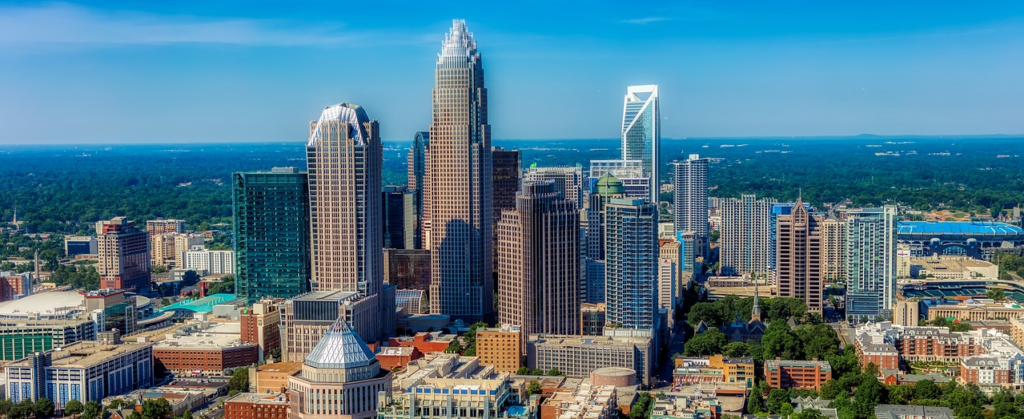
Reasons: Charlotte’s banking industry, coupled with a lower cost of living and high quality of life, attracts many Black professionals. Its strategic location in the Southeast also makes it a desirable relocation destination.
5. Phoenix-Mesa-Chandler, AZ (+33,653)

Reasons: Phoenix’s rapid job growth, especially in tech and manufacturing, along with its relatively affordable housing market, draws many seeking new opportunities and a warmer climate. A large number of the Black migrant population moved here from nearby California.
Top Losers: Economic Challenges and High Costs
SEE FULL LIST OF 133 CITIES AND THIER POPULATION CHANGE SINCE 2020
1. New York-Newark-Jersey City, NY-NJ (-144,415)
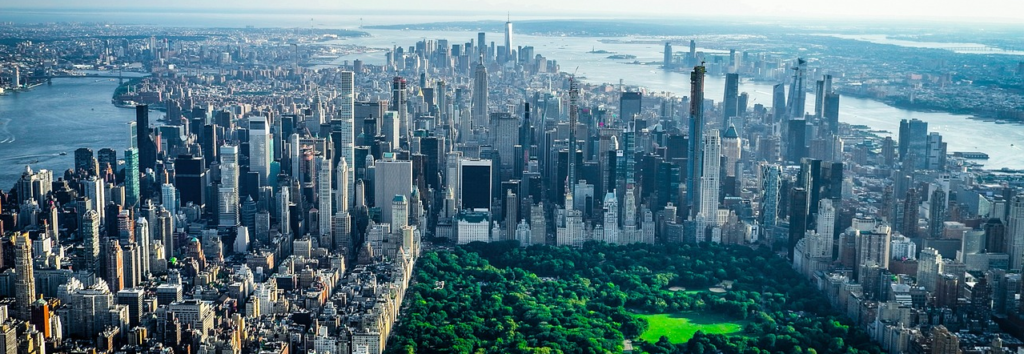
Reasons: The high cost of living, combined with the impact of the COVID-19 pandemic on employment, has driven many Black residents to relocate to more affordable areas with better job prospects.
2. Chicago-Naperville-Elgin, IL-IN-WI (-51,740)**
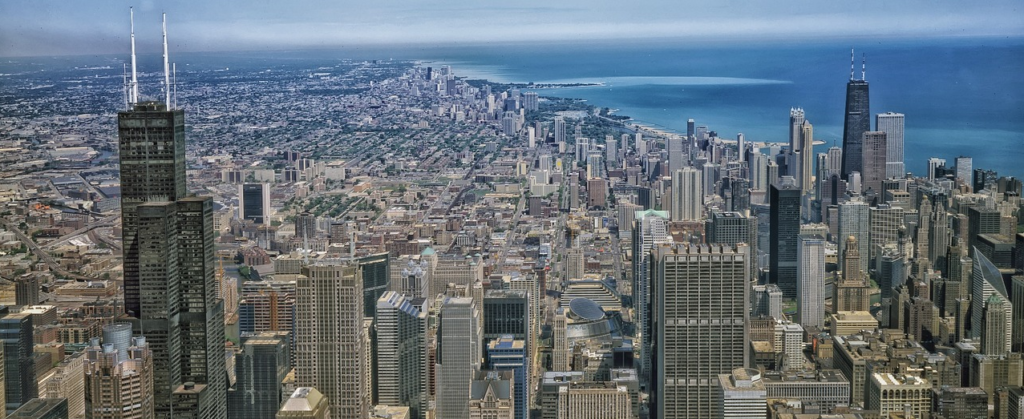
Reasons: Economic decline in certain sectors, combined with high crime rates and taxes, has led to out-migration. Many are moving to Southern states where the cost of living is lower, and opportunities are more abundant.
3. Los Angeles-Long Beach-Anaheim, CA (-35,708)**
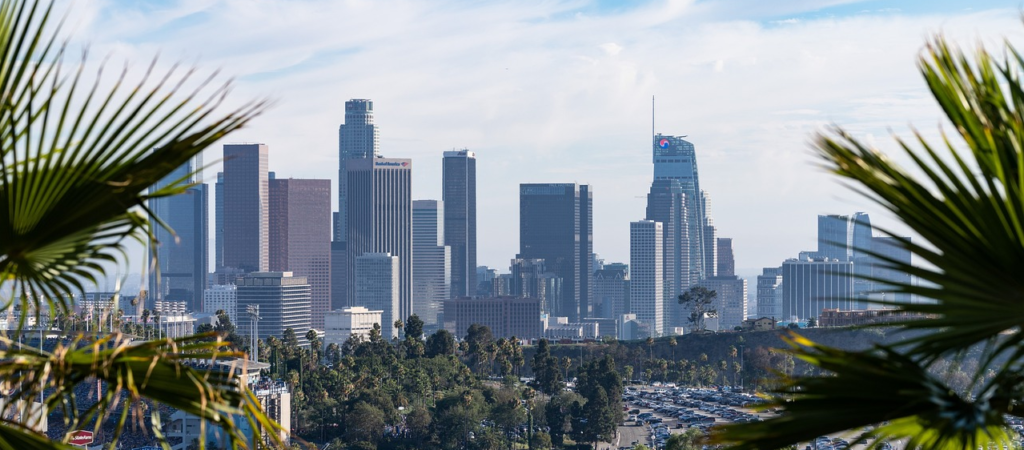
Reasons: The high cost of living, housing crisis, and competitive job market have pushed Black residents to seek better opportunities in more affordable regions.
4. New Orleans-Metairie, LA (-21,398)**
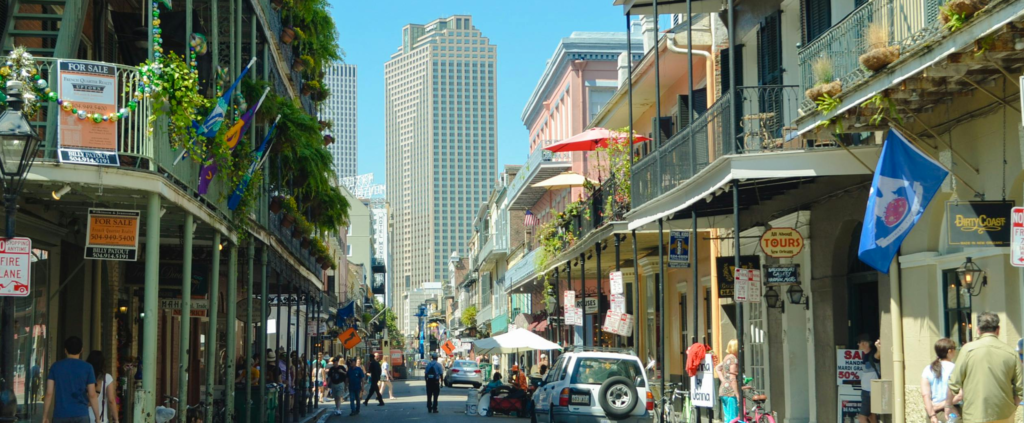
Reasons: Post-Hurricane Katrina recovery issues and limited economic opportunities have continued to drive out-migration. Many former residents moved to Texas and other Southern states for better prospects.
5. San Francisco-Oakland-Fremont, CA (-19,365)**
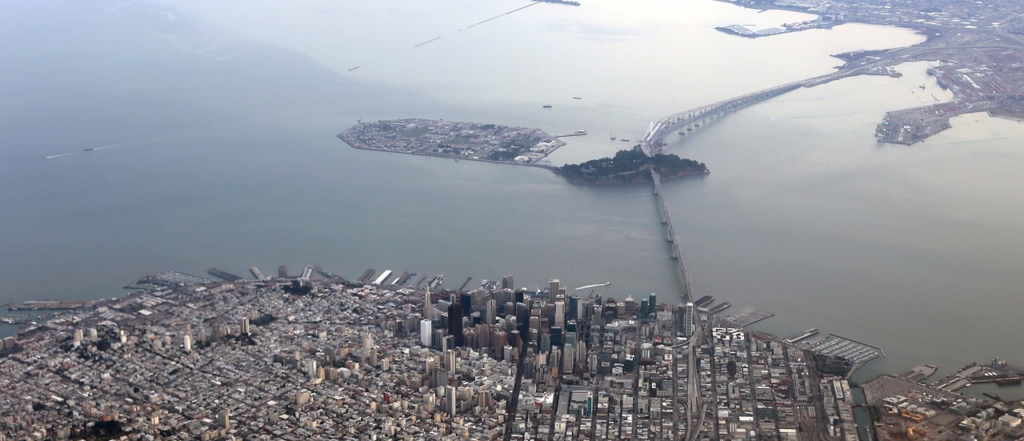
Reasons: The tech boom has significantly increased the cost of living, making it difficult for many Black residents to afford housing. This economic pressure has led to a demographic shift towards more affordable regions.
SEE FULL LIST OF 133 CITIES AND THIER POPULATION CHANGE SINCE 2020
Geographical Differences and Economic Histories
Southern Growth: The South has seen a significant increase in Black population due to its relatively lower cost of living, growing job markets, and a historically strong Black cultural presence. Cities like Atlanta, Dallas, and Houston are leading this trend.Dispite this trend there are areas of the South that have had the same economic problems as the Midwest.
Southern Cities Losing Black Population
1. Miami-Fort Lauderdale-West Palm Beach, FL (-10,672)**
Reasons: Rising living costs and economic pressures are contributing factors, prompting many to seek more affordable and opportunity-rich environments elsewhere. Many Miami residents are moving to cities like Orlando, FL; Atlanta, GA; and Charlotte, NC, which offer a lower cost of living and more job opportunities..
2. Jackson, MS (-6,489)**
Reasons: Economic difficulties, limited job growth, and high poverty rates have contributed to the out-migration of Black residents. Many have relocated to cities with more robust economies and opportunities for advancement.
3. Lake Charles, LA (-5,520)**
Reasons: Natural disasters, such as hurricanes, coupled with limited economic opportunities, have driven Black residents to move to areas with more stability and job prospects.
4. **Baton Rouge, LA (+4,760)**
– **Reasons:** While Baton Rouge has seen a slight increase, the growth rate is modest compared to other Southern cities, likely due to economic challenges and competition with neighboring Houston for job opportunities.
Northeastern and Midwestern Decline: Traditional Black urban centers in the Northeast and Midwest are experiencing declines due to economic stagnation, high living costs, and social challenges. Cities like New York, Chicago, and Cleveland are notable examples. However there are some exceptions in the region.
Midwest Cities Gaining Black Population
1. Indianapolis-Carmel-Greenwood, IN (+23,800)**
Reasons: Indianapolis has seen economic growth, particularly in the healthcare, education, and tech sectors. The city’s relatively affordable cost of living and proactive community initiatives aimed at improving quality of life have made it an attractive destination for Black families.
2. Columbus, OH (+24,927)**
Reasons: Columbus is a growing hub for tech and education, driven by institutions like Ohio State University and numerous startups. The city’s inclusive policies and vibrant cultural scene also contribute to its appeal for Black professionals and families.
3. Minneapolis-St. Paul-Bloomington, MN-WI (+30,492)**
Reasons: Despite the challenges faced by the Black community in recent years, including high-profile incidents of police violence, the Twin Cities continue to attract Black residents due to their strong job market, particularly in healthcare and education, and active community support networks.
SEE FULL LIST OF 133 CITIES AND THIER POPULATION CHANGE SINCE 2020
Historical Context: Black Migrations and Immigration
The historical context of Black migrations within the U.S. offers insights into current trends. The Great Migration (1916-1970) saw millions of Black Americans move from the rural South to urban centers in the North and West, seeking better economic opportunities and escaping racial segregation. In recent decades, a reverse migration trend has emerged, with many Black families moving back to the South, attracted by economic growth, cultural ties, and family connections. Although some return to the rural south near family, many move to some of the economic hotspots but stil within a days or a few hours drive from family.
Black Immigration: Global Influences
Black immigration from Africa, the Caribbean, and Latin America has also shaped the demographic landscape. Metropolitan areas with diverse and inclusive communities, such as Miami, Houston, and New York, continue to attract Black immigrants. These immigrants contribute to the cultural and economic vibrancy of their new homes.
Conclusion
The shifts in the Black population across U.S. metropolitan areas reflect a complex interplay of economic opportunities, cost of living, historical migration patterns, and cultural dynamics. While general trends indicate a migration towards the South and West, exceptions exist, with some Midwestern cities experiencing growth and certain Southern cities seeing declines. Understanding these nuanced patterns is crucial for policymakers, community leaders, and individuals seeking to navigate the changing landscape of Black America.
By recognizing these regional exceptions, we can gain a more comprehensive understanding of the factors driving population changes and work towards creating more inclusive and supportive communities nationwide.
SEE FULL LIST OF 133 CITIES AND THIER POPULATION CHANGE SINCE 2020

